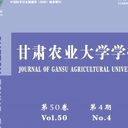Identification of the Fungal Pathogens of Postharvest Disease on Peach Fruits and the Control Mechanisms of Bacillus subtilis JK-14.
Keywords
Abstract
Postharvest fungal disease is one of the significant factors that limits the storage period and marketing life of peaches, and even result in serious economic losses worldwide. Biological control using microbial antagonists has been explored as an alternative approach for the management of postharvest disease of fruits. However, there is little information available regarding to the identification the fungal pathogen species that cause the postharvest peach diseases and the potential and mechanisms of using the Bacillussubtilis JK-14 to control postharvest peach diseases. In the present study, a total of six fungal isolates were isolated from peach fruits, and the isolates of Alternaria tenuis and Botrytis cinerea exhibited the highest pathogenicity and virulence on the host of mature peaches. In the culture plates, the strain of B. subtilis JK-14 showed the significant antagonistic activity against the growth of A. tenuis and B. cinerea with the inhibitory rates of 81.32% and 83.45% at 5 days after incubation, respectively. Peach fruits treated with different formulations of B. subtilis JK-14 significantly reduced the mean disease incidences and lesion diameters of A. tenuis and B. cinerea. The greatest mean percent reduction of the disease incidences (81.99% and 71.34%) and lesion diameters (82.80% and 73.57%) of A. tenuis and B. cinerea were obtained at the concentration of 1 × 107 CFU mL-1 (colony forming unit, CFU). Treatment with the strain of B. subtilis JK-14 effectively enhanced the activity of the antioxidant enzymes-superoxide dismutase (SOD), peroxidase (POD) and catalase (CAT) in A. tenuis and B. cinerea inoculated peach fruits. As such, the average activities of SOD, POD and CAT were increased by 36.56%, 17.63% and 20.35%, respectively, compared to the sterile water treatment. Our results indicate that the isolates of A. tenuis and B. cinerea are the main pathogens that cause the postharvest peach diseases, and the strain of B. subtilis JK-14 can be considered as an environmentally-safe biological control agent for the management of postharvest fruits diseases. We propose the possible mechanisms of the strain of B. subtilis JK-14 in controlling of postharvest peach diseases.



